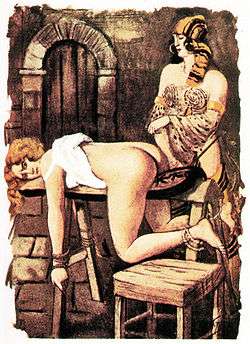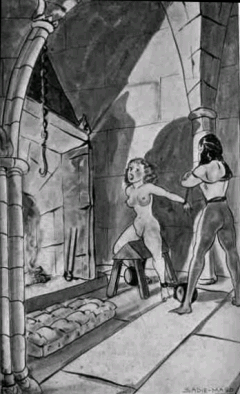Wooden horse (device)

A wooden horse (or Spanish donkey) is a torture device for women, of which there exist two variations; both inflict pain by using the subject's own weight to apply pressure to her genital region. The French called this instrument the Chevalet, from the French diminutive of cheval, horse.[1]
Torture device
The first variation of the wooden horse is a triangular device with one end of the triangle pointing upward, mounted on a saw-horse like support. The victim is made to straddle the triangular "horse." Weights or additional restraints were often added to keep the victim from falling off. A punishment similar to this called "riding the rail" was used during the American colonial period and later. The victim was often carried through town in this predicament, often in conjunction with the punishment of tarring and feathering. The crotch can be injured and the victim could be left unable to walk without pain.
While the device was designed for women, there are accounts of male victims as well. The Jesuit Relations say that in 1646, a man "was sentenced to make reparation, by the Civil authority, and to mount the Chevalet," and "a public blasphemer, was put on the Chevalet. He acknowledged his fault, saying that he had well deserved punishment, and came of his own accord to confess, that evening or the next day," and that another man "acted at the fort as such a glutton, that he was put on the Chevalet, on which he was ruptured."[2]
The device was used during the American Civil War by Union guards against their Confederate prisoners:
| “ | There were some of our poor boys, for little infraction of the prison rules, riding what they called Morgan's mule every day. That was one mule that did the worst standing stock still. He was built after the pattern of those used by carpenters. He was about fifteen feet high; the legs were nailed to the scantling so one of the sharp edges was turned up, which made it very painful and uncomfortable to the poor fellow especially when he had to be ridden bareback, sometimes with heavy weights fastened to his feet and sometimes with a large beef bone in each hand. This performance was carried on under the eyes of a guard with a loaded gun, and was kept up for several days; each ride lasting two hours each day unless the fellow fainted and fell off from pain and exhaustion. Very few were able to walk after this hellish Yankee torture but had to be supported to their barracks. | ” | |
| — Milton Asbury Ryan, Co. G, 8th MS Regiment | |||
The History Channel documentary Eighty Acres of Hell describes a torture device, "the mule", on which Confederate prisoners were forced to ride until they passed out; many were crippled for life.[3] The device was also used by Union officers on freedmen and women after the Civil War.[4]
BDSM

In BDSM play the wooden horse is used as a sexual torture device primarily or exclusively on women. Another version often dubbed the wooden pony is made of a single wooden plank supported horizontally from the floor on its side with the thin edge up. This version may have been invented because it is easier to make and more readily available than a triangular shape. The edges may be filed to a blunt point or rounded off to create a less immediately painful variation, or a thinner plank used to provide extra pressure and pain.
Both versions may be supported with legs or suspended from the ceiling. The victim is usually made to straddle it with her legs suspended in the air, either hanging freely or bent backwards. Her arms may be tied behind her back to prevent her from gaining any relief. They may also be pulled up behind her back in a strappado which itself acts as another form of torture while still preventing any leverage from being applied to gain relief. If the person is not required to support herself as an extra torture, rope tied around her chest, neck or hair may provide stabilisation without supporting her weight. Weights may be tied to her legs to cause more pain and discomfort or to provide stabilisation where rope isn't used.
In both versions the device is unobstructive enough to allow most other tortures to be applied at the same time including leaving a large enough area of the buttocks open for spanking, caning and whipping. The edge of the device may be positioned between the slit of her labia to ensure clitoral stimulation from straddling it. In extreme and more dangerous scenarios the sides are roughened or fitted with spikes. In a predicament scenario the device may be raised or lowered in order to make the person stand on her tiptoes or rest her body weight on her genitals on the device.

Roman empire
An unrelated device used during the Roman Empire to interrogate slaves was sometimes referred to as a "wooden horse." Its design was similar to the medieval torture rack in that it consisted of a raised platform (in this case approx. 1.8 meters from the ground) with pulleys at either end. The victim's arms and legs were tied to ropes which ran through the pulley systems and were attached to cranks at each end of the device. As tension was placed on both ropes, the shoulder (and possibly hip) joints were dislocated. The victim was then violently shoved off of the platform, creating more injuries to joints and muscles, before being beaten to death with rods.
See also
| Wikimedia Commons has media related to Spanish donkey. |
References
- ↑ http://www.merriam-webster.com/dictionary/chevalet
- ↑ http://puffin.creighton.edu/jesuit/relations/relations_28.html
- ↑ Eighty Acres of Hell (TV 2006) at the Internet Movie Database
- ↑ Foner, Eric (2002). Reconstruction: America's Unfinished Revolution, 1863–1877, p. 154. ISBN 9780060937164.